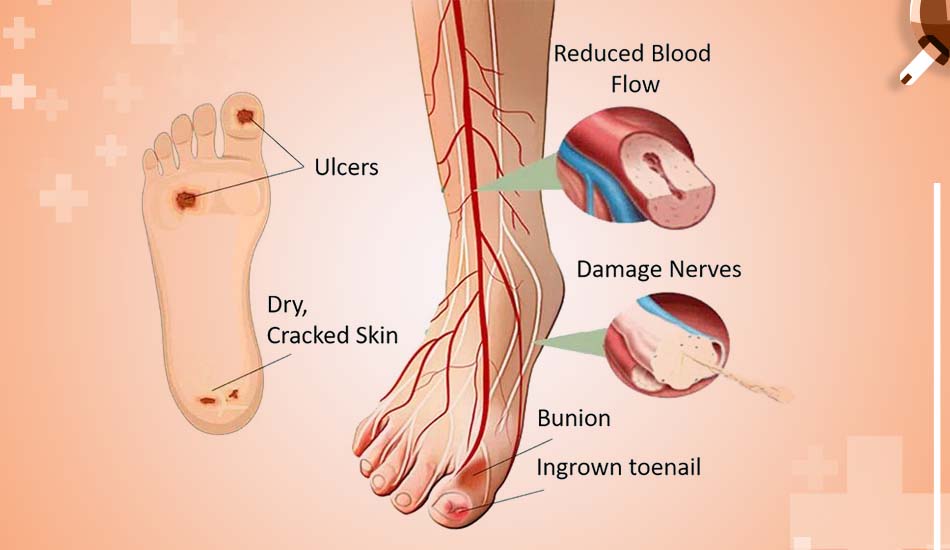
Diabetic Foot Ulcers Explained: Why They Happen and How to Prevent Them
Thursday, 23rd May 2024Diabetic foot ulcers are a serious complication of diabetes that can lead to severe health issues if not properly managed. Understanding why they happen and how to prevent them is crucial for anyone living with diabetes. This article delves into the causes of diabetic foot ulcers and provides practical tips on how to prevent them.
What Are Diabetic Foot Ulcers?
A diabetic foot ulcer is an open sore or wound that typically develops on the bottom of the foot in people with diabetes. These ulcers can become infected and, if not treated promptly, can lead to more severe complications, including amputation.
Why Do Diabetic Foot Ulcers Happen?
Poor Blood Circulation
Poor blood circulation is a common problem in people with diabetes, particularly affecting the legs and feet. Reduced blood flow can slow down the healing process of any cuts, blisters, or sores, making them more likely to develop into ulcers.
Nerve Damage
Nerve damage (neuropathy) caused by high blood sugar levels can lead to a loss of sensation in the feet. This means that small injuries or pressure points can go unnoticed and untreated, increasing the risk of ulcers.
High Blood Sugar Levels
High blood sugar levels can impair the body’s ability to fight infections and heal wounds. This makes it easier for ulcers to form and become infected.
Foot Deformities
Foot deformities such as bunions, hammertoes, or Charcot foot (a condition where the bones in the foot weaken) can cause abnormal pressure on the feet, leading to skin breakdown and ulcers.
Improper Footwear
Wearing improper footwear that does not fit properly or provide adequate support can create pressure points and blisters, which can turn into ulcers if not addressed.
How to Prevent Diabetic Foot Ulcers
Maintain Good Blood Sugar Control
Maintaining good blood sugar control is essential in preventing diabetic foot ulcers. Keeping blood sugar levels within the target range can help prevent nerve damage and improve circulation.
Inspect Your Feet Daily
Daily foot inspections are crucial for catching any issues early. Look for cuts, blisters, redness, swelling, or any changes in the skin or nails. Use a mirror or ask someone for help if you have difficulty seeing all parts of your feet.
Wear Proper Footwear
Choose proper footwear that fits well and provides good support. Avoid tight shoes, high heels, or shoes with pointed toes. Consider custom orthotics if recommended by your healthcare provider.
Keep Your Feet Clean and Dry
Wash your feet daily with mild soap and lukewarm water. Dry them thoroughly, especially between the toes, to prevent fungal infections. Moisturize your feet to keep the skin soft, but avoid applying lotion between the toes.
Trim Your Nails Carefully
Trim your toenails straight across and file the edges with a nail file to prevent ingrown toenails, which can lead to infections and ulcers.
Protect Your Feet
Always wear socks and shoes to protect your feet from injuries. Choose socks made of breathable materials and change them daily.
Avoid Smoking
Smoking impairs blood circulation, which can worsen foot problems in people with diabetes. Quitting smoking can significantly improve circulation and overall foot health.
Regular Foot Exams
Schedule regular foot exams with your healthcare provider or a podiatrist. They can detect early signs of foot problems and provide appropriate care to prevent ulcers.
Manage Other Health Conditions
Managing other health conditions, such as high blood pressure and high cholesterol, can improve overall circulation and reduce the risk of diabetic foot ulcers.
Treatment of Diabetic Foot Ulcers
Early Intervention
Early intervention is key to preventing complications. If you notice any signs of a foot ulcer, seek medical attention immediately.
Wound Care
Proper wound care is essential for healing diabetic foot ulcers. This may include cleaning the wound, applying dressings, and possibly using antibiotics to prevent or treat infection.
Offloading
Offloading involves reducing pressure on the ulcerated area. This can be achieved using special shoes, braces, or crutches to keep weight off the affected foot.
Surgery
In severe cases, surgery may be necessary to remove dead tissue, correct foot deformities, or improve circulation.
Conclusion
Diabetic foot ulcers are a serious complication that requires diligent prevention and management. By understanding the causes and implementing effective prevention strategies, people with diabetes can significantly reduce their risk of developing foot ulcers. Regular foot care, proper footwear, and maintaining good blood sugar control are key components of preventing diabetic foot ulcers. If you do develop an ulcer, seek prompt medical attention to prevent further complications and ensure proper healing.


